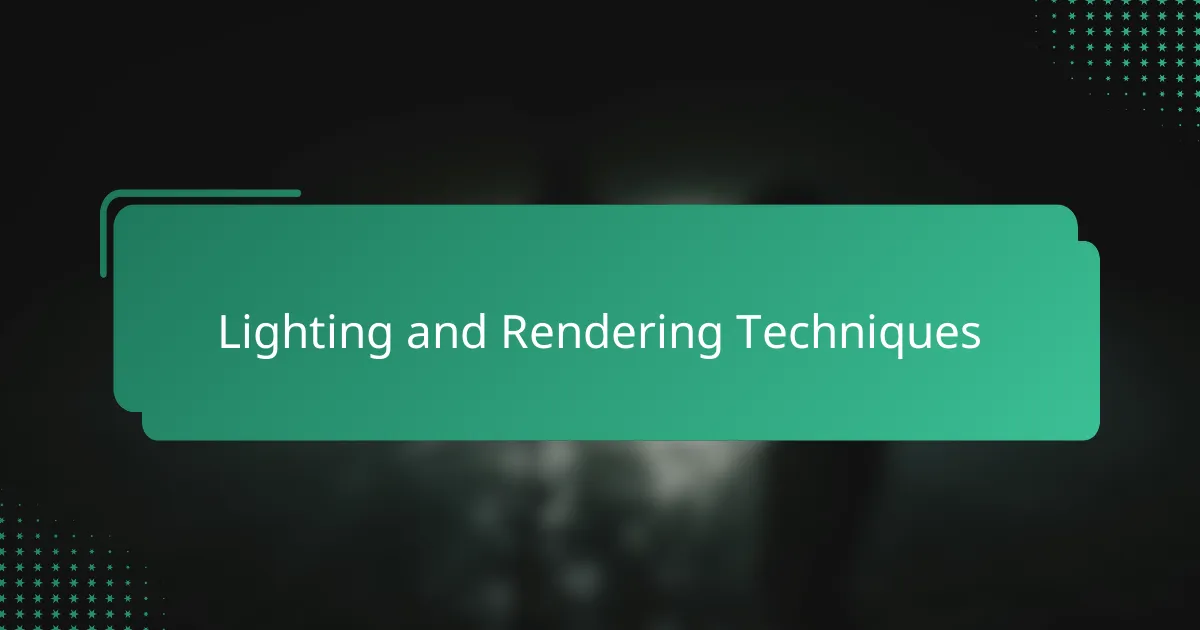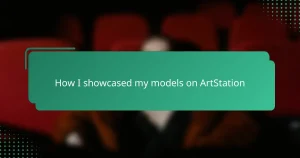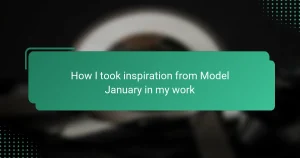Key takeaways
- Understanding sci-fi props goes beyond aesthetics; they embody stories of technology and culture.
- Blender is a powerful tool for prop creation, offering flexibility in modeling, texturing, and lighting.
- Mastering basic tools and efficient workflows in Blender enhances creativity and streamlines the design process.
- Attention to detail in texturing and lighting elevates props from basic models to believable, immersive elements.

Understanding Science Fiction Props
Science fiction props have always fascinated me because they blur the line between imagination and reality. When I first started exploring them, I realized that these objects aren’t just about looking futuristic—they tell stories about technology, culture, and possibilities. Have you ever wondered what makes a prop truly believable in a sci-fi world?
In my experience, understanding these props means diving into their design logic. Why does a weapon have those shapes? What kind of future society would use that gadget? Thinking about these questions helped me appreciate the subtle details and made my own creations feel more authentic.
Sometimes, a simple prop can evoke powerful emotions—curiosity, wonder, even nostalgia. I find that when you grasp the deeper meaning behind each piece, your work connects better with the audience. Isn’t that what every artist hopes to achieve?

Introduction to Blender for Props
Blender quickly became my go-to tool when I decided to bring my sci-fi prop ideas to life. At first, the interface felt overwhelming, like stepping into a starship cockpit without a manual. But as I started experimenting, I realized how intuitive and powerful it truly is for modeling detailed objects.
What makes Blender stand out for me is its flexibility. Whether crafting sleek weapons or complex gadgets, I could shape every curve and surface just the way I imagined. Have you ever felt that thrill when a virtual model begins to mirror the vision in your mind? That’s the magic Blender offers.
Beyond just modeling, Blender’s ability to texture and render props adds another layer of realism. It’s not just about shapes but also how materials respond to light—details that really sell the futuristic feel. This attention to detail transforms my digital creations into convincing elements ready for any sci-fi setting.

Basic Blender Tools for Prop Making
Mastering Blender’s basic tools was a game changer for me when I started making sci-fi props. I remember being amazed at how the Grab, Rotate, and Scale tools gave me immediate control over shaping objects. It’s like having a virtual clay at your fingertips, allowing me to experiment freely without fear of messing up.
One tool I found indispensable was the Extrude function. It lets you pull faces and edges out from your model, adding depth and complexity in ways that feel surprisingly natural. Have you ever felt that rush when a flat shape suddenly becomes a tangible, three-dimensional form? Extrude always gave me that moment of creative magic.
Navigating Blender’s modifiers also changed how I approached prop creation. For example, the Mirror modifier saved me tons of time by duplicating one side of my model perfectly. It’s those little efficiencies that let me focus more on the design and storytelling aspects of my sci-fi props, rather than getting bogged down in repetitive work.

Modeling Sci-Fi Props Step by Step
When I start modeling a sci-fi prop in Blender, my first step is always blocking out the basic shapes. I focus on getting the silhouette and proportions right before diving into the details because a strong foundation often makes the entire process smoother. Have you noticed how a well-crafted outline can already hint at the story behind the prop?
After establishing the form, I gradually add complexity by using tools like Loop Cut and Bevel to refine edges and create mechanical details. This phase demands patience, but I find it incredibly rewarding when flat surfaces transform into intricate panels and grooves that feel like they belong to a high-tech world. It’s like revealing secrets hidden in the design, and that feeling keeps me hooked.
Finally, I switch to fine-tuning small features—buttons, vents, and subtle asymmetries—that make the prop feel lived-in and believable. Sometimes, I step back and ask myself: does this piece tell a story? These tiny touches are where my work goes from generic sci-fi to something uniquely personal and authentic. Have you ever felt that tiny details carry the soul of a design? I certainly have.

Texturing and Detailing Props
Texturing and detailing props in Blender felt like giving life to my models. I remember the first time I experimented with bump and normal maps—suddenly, flat surfaces gained depth, wrinkles, and scratches that hinted at years of use or advanced technology. Doesn’t adding these imperfections make a prop feel like it’s part of a real, functional world?
One of the most thrilling aspects was selecting materials that matched the story behind each prop. Should this weapon gleam with polished metal, or wear the matte scars of battlefield wear? I often played with metallic and roughness sliders until I found that perfect balance where the prop seemed ready to leap off the screen into a sci-fi film.
Detailing isn’t just about texture, though; it’s about subtle extras like decals, wires, or even tiny screws that enrich the narrative visually. I sometimes ask myself, “What small signs would show this object’s history or purpose?” Answering that led me to add layered details that invite viewers to look closer, making the prop not just seen, but experienced.

Lighting and Rendering Techniques
Lighting and rendering in Blender truly brought my sci-fi props to life in a way I hadn’t expected. Setting up the right light sources felt like directing a play—each light needed to highlight key features while casting shadows that added depth and mood. Have you ever noticed how a single well-placed light can transform a flat model into something dynamic and believable? That moment amazed me every time.
When I first experimented with Blender’s rendering engines like Eevee and Cycles, I realized they offered very different vibes. Eevee’s speed let me quickly test lighting setups, which was great for iterating fast. But Cycles, with its realistic ray tracing, gave my props that subtle glow and reflections that made metal parts look genuinely futuristic. Choosing between speed and realism became a creative challenge I enjoyed.
I also played around with HDRI environments to simulate real-world lighting conditions. It was fascinating how a simple sky texture or studio backdrop could affect reflections and color tones on my models. These subtle lighting tweaks might seem minor, but they made me feel like I was photographing a real object, not just rendering pixels. Doesn’t that pursuit for authenticity drive every sci-fi prop artist? It certainly drives me.

Tips from My Blender Prop Workflow
One tip I’ve learned is to keep my Blender scenes organized from the start. Naming objects clearly and using collections saved me countless headaches later, especially when the prop got complex. Have you ever tried hunting for a stray mesh hidden deep in your outliner? It’s frustrating, but staying tidy feels like laying down a smooth flight path before takeoff.
Another workflow habit I swear by is constantly switching between solid and rendered views. Seeing the model’s shape clearly helps me focus on form, while jumping into rendered mode lets me catch lighting and texture issues early. It’s like getting a reality check for your sci-fi creation, reminding me that even the coolest shape falls flat without the right materials and light.
Lastly, I can’t emphasize enough the value of using Blender’s shortcuts and custom pie menus. Learning these streamlined my workflow dramatically—I cut down time on repetitive actions and spent more moments actually creating. Do you ever feel stuck juggling too many clicks? Once I embraced hotkeys, my hands felt freer, and creativity flowed more naturally.


